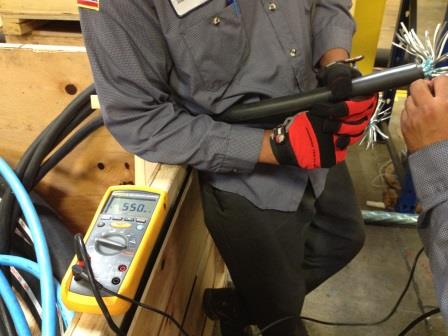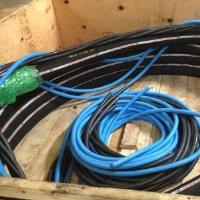Third Party Inspection for Power Cable - Procedure
Third Party Inspection for power cable is a sample procedure for power cable testing and power cable inspection in the manufacturing shop. You might want to review this article with power cable inspection and test plan.
This content guides you through all the necessary stages in the production of the power cables, including the raw material, final inspection, preservation and packing, and dispatch to site.
You need to take this point into account: this article is written for a typical power cable and might not be detailed for special cases.

All power cable inspection and testing is done against the approved drawings, purchase order specifications, purchasers or company standards, and within the practices and rules of the country, state or province and any government decrees, laws, ordinance or regulation as may apply.
The applicable codes and specifications for a power cable that is under the construction process is:
- Design code
- Purchase order specification
- Purchaser's standards
- Approved drawings
the applicable codes and standards may be based on any international standards. This content is general and can be useful for all recognized standards.
Required Documents for Third Party Inspector Review:
The list of documents normally is agreed upon in the Pre-Inspection meeting, which is held several weeks before the actual commencement of the inspection work. The parties that participate in this meeting are the manufacturer, purchaser and third party inspection agency representatives.
These are the list of documents that are normally agreed upon to be presented to the inspector:
- Power Cable Purchase Order or Contract
- Power Cable Quality Control Plan
- Power Cable Inspection and Test Plan
- Power Cable Data Sheet
- Power Cable Approved Drawings
- Power Cable Fittings Drawings and/or Parts Lists
- Power Cable Material/parts Certificates
- Power Cable FAT Test Procedure (Electrical Test)
- Power Cable Special Procedures
- Power Cable Special Qualifications
- Power Cable Calibration Records for Testing and Measuring Equipment
- Preservation, packing and Shipping Procedure
- Power Cable Packing List
Third Party Inspection for Power Cable - Material Inspection
The first actual inspection work in the power cable is the raw materials inspection.
The original or authenticated copies of mill certificates of material normally are available at the manufacturer's premises.
The third party inspector examines these certificates for compliance with specifications, and where appropriate, drawings.
The review includes checks on:
- Maker’s name and location
- Certificate number, grade
- Heat or cast number
- Chemical composition
Then the inspector witnesses the materials identification on the certificates against the materials marking. It is also necessary to check these with the power cable drawing datasheet, material list and other specifications as appropriate.
Visual inspection for surface finish and probable defects is done and dimensional compliance with specification need to be controlled, as well.
When the third party inspector carries out the material inspection, then provides the inspection visit report (IVR), the report contains the following items:
- Confirmation of satisfactory document review
- Record of the endorsement of certification reviewed/witnessed
- Record of all non-conformities
- Record of any tests witnessed and the result
Third Party Inspection for Power Cable - Construction Check
When the power cable raw material inspection is carried out, and the results were satisfactory or non-conformities were closed by remedial action, then the power cable manufacturer will start fabrication.
The third party inspector checks the following points on the power cable, based on the inspection and test plan (ITP), which has already been agreed upon between the purchaser and the power cable manufacturer.
The inspection scope is determined in the ITP. Some purchasers prefer to have stringent controls and assign the TPI for more “hold or witness points” for inspection and test activities, and some others prefer less “hold or witness points” and assign the TPI much more work in the “review document.”

This depends in the inspection budget, which purchasers assign for inspection. Much more inspection will have a much larger cost and less risk, and conversely, less inspection will have less cost but more risks.
For more details, review the Inspection and Test Plan for Power Cable article. There is a draft of the ITP in this article, which we believe is the best practice for power cable inspection.
The third party inspector checks the following items in the power cable casing inspection process:
- Check of paint using specified colour swatch, measure thickness, if specified
- Check of name plate
- Check of outline dimensions, interface dimensions
- Power Cable General Arrangement Check
Third Party Inspection for Power Cable - Configuration
Third party inspector checks the power cable configuration in accordance to drawing and datasheets. Following items is taken in account:
- Cable type
- Number of conductors
- Conductor size
- Conductor color coding
- Insulation type and size
- Fillers
- Water stoppers
- Armour
- Shield
- Outer diameter
- Other specified elements/dimensions
- Cable identification
Third Party Inspection for Power Cable - Drum
For cable already drummed the third party inspector controls following items:
- Labelling
- Sealing
- Lagging
- Drum quantity
- Conformance of quantity listings on drums to documented declarations
Third party inspection for Power Cable - Conductor Resistance Test
The third party inspector witnesses the measurement which is done
by “Kelvin’s Double Bridge” or “Wheatstone Bridge” and checks the result against acceptance criteria specified in the purchase order.
Third Party Inspection for Power Cable - Withstand Voltage Test
The AC and DC withstand voltage test is witnessed by third party inspector for each length of completed cable as below:
- AC Withstand Voltage Test:
The test voltage is applied between the conductor or conductors and metallic shield, metallic armour, or water. The duration is 5 minutes and the test would be acceptable if withstand the specified test voltage.
- DC Withstand Voltage Test (ICEA only):
All cables rated 5001 volts and above is tested by the DC withstand voltage test and would be acceptable if withstand specified test voltage
Third Party Inspection for Power Cable - Insulation Resistance Test
The insulation resistance test is measured after the completed cable AC voltage test or before any DC voltage test and witnessed by third party inspector.
Reading of the insulation resistance is taken for one minute and obtained value would be acceptable if they are above the specified value in the requirement.
Third Party Inspection for Power Cable - Discharge Test
The partial discharge test is made prior to the AC voltage test as per the appropriate test method specified in the code and standard. The AC test voltage is applied between conductor and the metallic component of insulation shield
If the existence of discharge is not evident after the voltage has been raised to a value 20% above the specified minimum extinction value, the cable is considered to have met the requirements.
Third Party Inspection for Power Cable - Tensile Strength and Elongation Test
Physical tests are made at room temperature and the test specimens are kept at room temperature for not less than 30 minutes prior to the test.
The specimen is stretched until it breaks. Elongation at rupture is determined simultaneously with the test for tensile strength and on the same specimen.
The tensile strength is calculated on the area of the unstretched specimens. The percentage of elongation at rupture is divided by the original gauge length and multiplied by 100. They would be acceptable if meet the requirements.
Third Party Inspection for Power Cable - Aging Test
The test specimens are heated at the required temperature for the specified period in air oven or immersed in oil hot oil.
The kind of oil, temperature and duration is in accordance of applicable standards.
Physical tests on both the aged and unaged specimens are made at the same time and the result of the test would be acceptable if comply with the requirement
Third Party Inspection for Power Cable - Heat Shock Test
Samples of the cables are wound around a mandrel, held firmly in place and subjected to the specified temperature for 1 hour. Diameter of mandrel is specified in the standard.
The test specimen would be acceptable if show no cracks visible to the normal unaided eye.
Third Party Inspection for Power Cable - Heat Distortion Test
The test is made in accordance with appropriate method specified in the standard (ICEA). The test would be acceptable if obtained value is not exceeding the maximum percentage of unaged value specified in ICEA.
Third Party Inspection for Power Cable - Flame Resistance Test
Flame resisting test is made in accordance with respective code, standard. (IEC, IEEE) and after the test, the test would be acceptable if specimens meet the requirement of applicable code, standard.
Reporting
The third party inspector provides an Inspection Visit Report (IVR) after each visit, as well as a final report summarizing the activities carried out during the power cable production in accordance with the contract requirements and circulated within the time limits specified in the contract.
The report is in the format required by the client and clearly indicates final acceptance or rejection of the power cable.
Release Note
When required by the contract or purchase order, a release note is issued by the third party inspection agency and given to the manufacturer when the power cables have been accepted.
Packing and Marking
The following points are checked by the third party inspector for packing inspection:
- Drum marking and tagging.
- Cable end secured.
- The reel is lagged or covered with suitable material to provide physical protection for the cables during transit.
- Cable end sealed against moisture.
- Verify that the packing materials conform to specifications and accepted practice for the mode of transport.
- Check protection against humidity, abrasion, distortion and other damage.
- Check shipping marks with marking instructions and record. Check handling marks.
Free newsletter!
Sign up to receive my monthly newsletter covering all the latest courses and updates.




New! Comments
Have your say about what you just read! Leave me a comment in the box below.